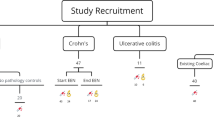Abstract
Purpose
Several researchers have found that plasma citrulline could be a marker of reduced enterocyte mass. The aim of this study was to assess the relationship between plasma citrulline and bowel inflammation and/or disease location in pediatric and adolescent Crohn’s disease (CD) patients.
Methods
Between January 2008 and January 2010, 31 CD patients and 44 controls were included in our study, and 15 out of the 31 CD patients continued a prospective survey. We evaluated the differences between groups, at baseline, in plasma citrulline and glutamine and between their baseline and final values during the prospective survey, and correlation between baseline values of citrulline and duration of disease, C-reactive protein, and fecal calprotectin.
Results
Mean citrulline value was 33.0 ± 7.5 μmol/L in controls and 23.5 ± 8.4 μmol/L in CD patients (P < 0.0001). Plasma citrulline was significantly lower in patients with small bowel (SB) location than in patient with only ileo-colon disease (14.2 ± 5.5 and 24.7 ± 8.0, respectively; P = 0.0037). Citrulline ≤22 μmol/L reached sensitivity of 100% (95% confidence interval (CI) 54–100) and specificity of 98% (CI 89–99) in differentiating control subjects from CD with SB location.
Conclusions
CD patients have reduced concentration of plasma citrulline than controls. Intestinal damage rather than inflammation seems to be responsible for the reduced biosynthesis of citrulline, which decreases particularly in CD patients with SB location. This finding suggests the potential role of citrulline as marker of disease location, but future works will be needed to confirm this suggestion.




Similar content being viewed by others
References
Crenn P, Messing B, Cynober L (2008) Citrulline as a biomarker of intestinal failure due to enterocyte mass reduction. Clin Nutr 27:328–339
Crenn P, Vahedi K, Lavergne-Slove A et al (2003) Plasma citrulline: a marker of enterocyte mass in villous atrophy-associated small bowel disease. Gastroenterology 124:1210–1219
Bailly-Botuha C, Colomb V, Thioulouse E et al (2009) Plasma citrulline concentration reflects enterocyte mass in children with short bowel syndrome. Pediatr Res 65:559–563
Rhoads JM, Plunkett E, Galanko J et al (2005) Serum citrulline levels correlate with enteral tolerance and bowel length in infants with short bowel syndrome. J Pediatr 146:542–547
Crenn P, Coudray-Lucas C, Thuillier F et al (2000) Postabsorptive plasma citrulline concentration is a marker of absorptive enterocyte mass and intestinal failure in humans. Gastroenterology 119:1496–1505
Crenn P, Coudray-Lucas C, Cynober L et al (1998) Post-absorptive plasma citrulline concentration: a marker of intestinal failure in humans. Transplant Proc 30(6):2528
Jianfeng G, Weiming Z, Ning L et al (2005) Serum citrulline is a simple quantitative marker for small intestinal enterocytes mass and absorption function in short bowel patients. J Surg Res 127:177–182
Fitzgibbons S, Ching YA, Valim C et al (2009) Relationship between serum citrulline levels and progression to parenteral nutrition independence in children with short bowel syndrome. J Pediatr Surg 44(5):928–932
Pappas PA, Tzakis AG, Gaynor JJ et al (2004) An analysis of the association between serum citrulline and acute rejection among 26 recipients of intestinal transplant. Am J Transplant 4(7):1124–1132
Lutgens L, Lambin P (2007) Biomarkers for radiation-induced small bowel epithelial damage: an emerging role for plasma citrulline. World J Gastroenterol 13(22):3033–3042
Papadia C, Sherwood RA, Kalantzis C et al (2007) Plasma citrulline concentration: a reliable marker of small bowel absorptive capacity independent of intestinal inflammation. Am J Gastroenterol 102:1474–1482
Buchman AL, Katz S, Fang JC et al (2010) Teduglutide, a novel mucosally active analog of glucagon-like peptide-2 (GLP-2) for the treatment of moderate to severe Crohn’s disease. Inflamm Bowel Dis 16(6):962–973
Hyams JS, Ferry GD, Mandel FS et al (1991) Development and validation of a pediatric Crohn’s disease activity index. J Pediatr Gastroenterol Nutr 12:439–447
Fagerberg UL, Lööf L, Lindholm J et al (2007) Fecal calprotectin: a quantitative marker of colonic inflammation in children with inflammatory bowel disease. J Pediatr Gastroenterol Nutr 45(4):414–420
Levine A (2009) Pediatric inflammatory bowel disease: is it different? Dig Dis 27(3):212–214
Konikoff MR, Denson LA (2006) Role of fecal calprotectin as a biomarker of intestinal inflammation in inflammatory bowel disease. Inflamm Bowel Dis 12:524–533
Tibble J, Teahon K, Thjodleifsson B et al (2000) A simple method for assessing intestinal inflammation in Crohn’s disease. Gut 47:506–513
Schroder O, Naumann M, Shastri Y et al (2007) Prospective evaluation of faecal 337 neutrophil derived proteins in identifying intestinal inflammation: combination of parameters does not improve diagnostic accuracy of calprotectin. Aliment Pharmacol Ther 26(7):1035–1042
Sidoroff M, Karikoski R, Raivio T et al (2010) High-sensitivity C-reactive protein in paediatric inflammatory bowel disease. World J Gastroenterol 16(23):2901–2906
Tilakaratne S, Lemberg DA, Leach ST et al (2010) C-reactive protein and disease activity in children with Crohn’s disease. Dig Dis Sci 55(1):131–136
Palmon R, Brown SJ, Abreu MT (2008) What is the role and significance of serum and stool biomarkers in the diagnosis of IBD? Inflamm Bowel Dis 14(Suppl 2):S187–S189
Crenn P, De Truchis P, Neveux N et al (2009) Plasma citrulline is a biomarker of enterocyte mass and an indicator of parenteral nutrition in HIV-infected patients. Am J Clin Nutr 90(3):587–594
Papadia C, Kelly P, Caini S et al (2010) Plasma citrulline as a quantitative biomarker of HIV-associated villous atrophy in a tropical enteropathy population. Clin Nutr 29(6):795–800
Stange EF, Travis SPL, Vermeire S, for the European Crohn’s and Colitis Organisation (ECCO) et al (2006) European evidence based consensus on the diagnosis and management of Crohn’s disease: definitions and diagnosis. Gut 55(Suppl I):i1–i15
Leighton JA, Legnani P, Seidman EG (2007) Role of capsule endoscopy in inflammatory bowel disease: where we are and where we are going. Inflamm Bowel Dis 13(3):331–337
Acknowledgments
This study was partially supported by the Italian Ministry of Health that provided a Grant for a Clinical Fellowship.
Author information
Authors and Affiliations
Corresponding authors
Rights and permissions
About this article
Cite this article
Diamanti, A., Knafelz, D., Panetta, F. et al. Plasma citrulline as surrogate marker of intestinal inflammation in pediatric and adolescent with Crohn’s disease: preliminary report. Int J Colorectal Dis 26, 1445–1451 (2011). https://doi.org/10.1007/s00384-011-1255-z
Accepted:
Published:
Issue Date:
DOI: https://doi.org/10.1007/s00384-011-1255-z




